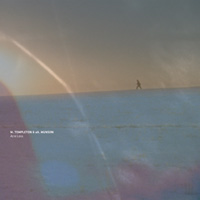
M. Templeton + aA. Munson
Acre Loss
(Anticipate; 2009)
By Joel Elliott | 13 February 2009
Non-narrative cinema has always had a complicated relationship with music. When I took a course in my undergraduate degree on Avant-Garde and Experimental Cinema, my professor made a comment—in regards to Stan Brakhage, who had a strict no-soundtrack policy—about music existing primarily to make experimental films easier to sit through. It almost seems like a conciliatory gesture towards people who find these films too “difficult,” but there’s no denying that the way in which music can exist without images doesn’t seem to extend to the reverse scenario.
This idea of music serving a token or secondary role in cinema is precisely what aAron Munson and Mark Templeton seem to be trying to overturn on their audio/video collaboration Acre Loss. The project is a full-blown collaboration: each component seems to have been created in parallel and you get the sense that there was a lot of back-and-forth, as opposed to Templeton simply scoring Munson’s videos or Munson structuring his films around Templeton’s music. The liner notes even give both members credit on both elements, though given each artist’s specific background, there was probably more division of labour than this might suggest. The package comes with an audio-only CD as well as DVD, but the music doesn’t quite stand up on its own; at least not in the way that Templeton’s exceptional Standing on a Hummingbird (2007) does.
But as a complete package, Acre Loss provides an incredible synthesis of sound and vision. Both Munson and Templeton hail from Edmonton, and the Canadian winter seems to play a pivotal role. But rather than depicting a bleak wasteland, it conveys a sense of people interacting with their snow-covered environment. Templeton’s use of household items as source material—the light clanging of dishes and other incidental, domestic sounds—gives a strange sense of comfort, highlighting the slow movements of people going about their mundane daily activities in the midst of winter.
Using a combination of Super 8 and 16 film with modern HD processes, Munson gives a more painterly than naturalistic treatment, at times even rendering his material completely abstract. He often creates movement where there isn’t any: opener “aTest” follows a rapid succession of blurred black-and-white images with a repeated movement of the camera vertically along a 180° axis, catching the bare branches of a tree on the way up, and feet walking along a sidewalk on the bottom. Rather than adopting the usual Minimalist steady cam, Munson allows the camera to shift around erratically, giving the impression of a dizzying subjectivity despite the strict, linear movements. On “It’s OK to Fall” he combines a shaky low-angle shot of a telephone pole that makes the wires seem like strings of a marionette with other shots that transform static patterns into rapid shifts of light. Here the two artists show an incredible ability to respond to each other, with Templeton layering guitar drones that also, despite being relatively unchanging, give the impression of measured pulses underneath.
Rather than seeing Munson’s use of modern video techniques alongside grainy 8mm footage as being a transformation of natural phenomena, it might be more fitting to consider his images as documenting the organic patterns behind modern technological processes—a concept that I already found in Templeton’s music before I’d seen the film. “Saw to the Seed” opens with a double set of windows and a leaning tree visible outside, with one of the windows containing snaky bits of white static and a beautiful shot of someone running away. Not within the world of the window, but like the static, transposed in a haunting way; following in the long-standing cinematic metaphor of window-as-gateway-to-dreams. The music itself oscillates between lyrical guitar and bursts of static that often completely obscure the instrumentation, with a dark slow-exposure shot of shifting clouds layered over with close-ups of aquatic bubbles that occasionally look like snow but shift and disperse in all directions. The sheer visual impact of the images is striking on its own, but by combining images that still retain representative qualities—much like the muffled collection of unintelligible voices that round out the track—they manage to do one of the most admirable things you can do in any art form: to show the viewer/listener how the artists are transforming reality, rather than simply transforming it.
But by far the most staggering thing here, visually and musically, is “Safer,” both artists’ most minimal track. Amidst what could be the ocean or just the sound of traffic (a sign of Templeton’s incredible ability to make typically banal, artificial sources sound like epic natural phenomena and vice-versa) and two clean guitar chords, Munson depicts an empty, snowy field with sunset-colored filters. The rest of the track has a distant figure walking across the horizon while Munson puts scratchy leader rising above him in the sky. At times the leader looks like really heavy rain, but then transforms into expressionist swirls. It’s hard to describe the impact since they use so many well-worn cliches of both art-forms—prosaic nature shots, ultra-minimalist long takes, scratched 8mm film, the combination of guitar and field recordings—but the effect is breathtaking; something about the smallness but persistence of humanity in the face of chaos, or however you choose to interpret it. It makes you wonder why, with so many filmmakers and musicians working in a similar vein to both Templeton and Munson, that such synaesthetic explorations aren’t more commonplace.





